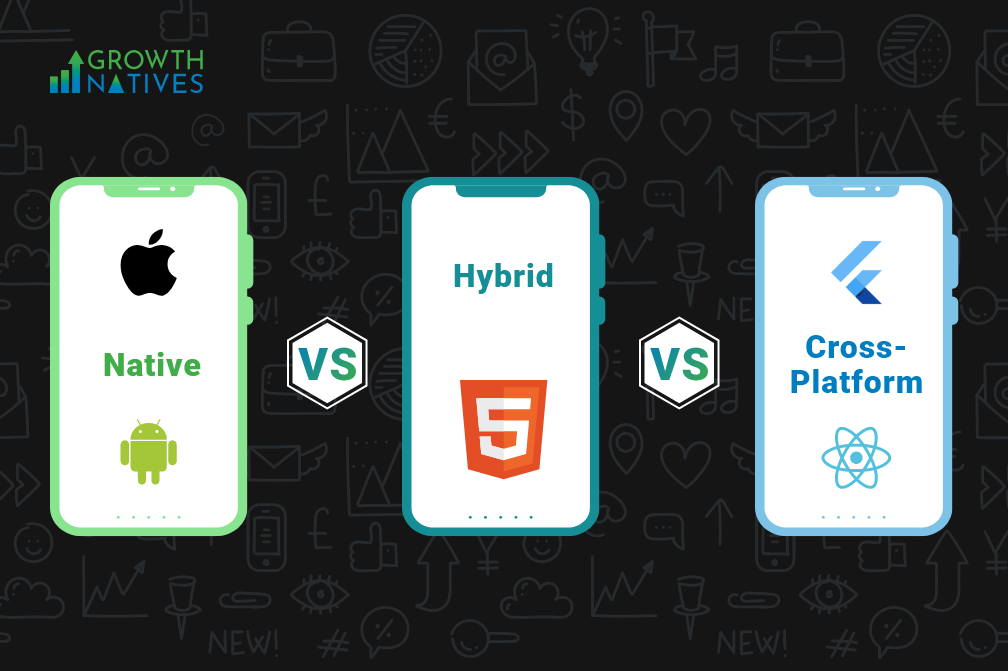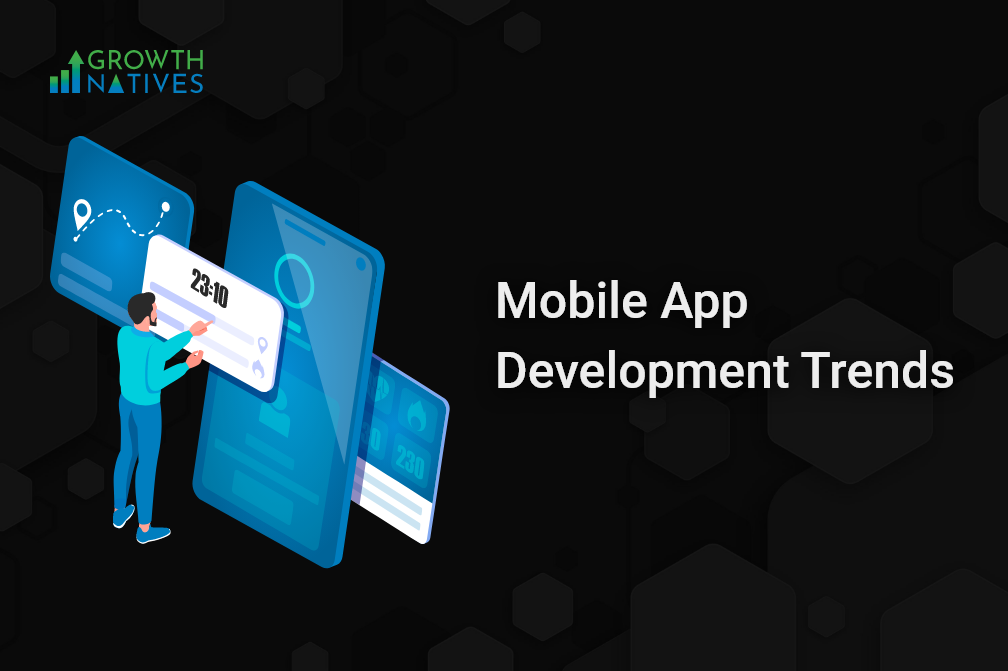Top 12 Mobile App Development Trends for 2023 and Beyond

Table of Contents
What is the one thing that Uber Eats, Netflix, and Zoom have in common? A carefully implemented mobile strategy! Uber Eats or Netflix has changed the way both businesses and consumers see mobile applications. From predictive analysis to simple and clear UI, there is a myriad of things that make these applications our favorites.
The pandemic accelerated the demand for mobile applications, resulting in the transition of mobile-first solutions. As more contemporary consumers use their phones to pay their bills, communicate with colleagues through various chat applications, and make new connections, the need for high-quality mobile apps with this functionality rises.
This is increasing the demand for mobile apps – where developers are building solutions to assist businesses to become more agile and mobile-friendly. By 2026, Statista predicts a $542.80 billion global market for mobile apps.
If you want to make a positive impression on your clients, regardless of whether your organization is just getting off the ground or is experiencing development or expansion, you must decide what kind of mobile strategy you will embrace in the coming years.
In this article, we will discuss the top 12 cutting-edge mobile app trends that you can employ to attract in, convert, and retain your target audience.
Top 12 Mobile App Development Trends for 2023 and Beyond
1. More Demand for Augmented Reality (AR) and Virtual Reality (VR)
Augmented Reality (AR) and Virtual Reality (VR) streamline the physical and virtual world. It is predicted that the global AR and VR market will reach $250 billion dollars by 2028, according to Statista.
Whether it is the success of AR filers in social media applications like Instagram and Snapchat or in online retail sectors like jewelry stores or home furnishing, the world can see the popularity of augmented reality and virtual reality applications.
Besides interactive gaming, AR hands-on training experience, such as training simulators or interactive classrooms. This shows the trend of AR and VR will only grow in the future – as more and more businesses will implement this technology to display their products in the virtual world.
2. Increased Emphasis on User Interface (UI) and User Experience (UX)
A clean and simple design has been the key to attracting mobile users because of the small screen size. Time and again it has become obvious that people prefer simple, minimalistic, and clear interfaces.
Since people use smartphones more than ever, there has been an increased focus on UI and UX for mobile app development. From banking to shopping or learning to entertainment and more, there has been a high demand for mobile apps in recent years.
Thus, it becomes important to create apps that are easy to use and visually attractive. The increasing demand for UI/UX has fostered many innovative ideas in mobile app development.
3. Enhanced Performance with Artificial Intelligence (AI)
The advancements in artificial intelligence (AI) incorporate features in applications that will enhance performance and improve user experience. The way AI has been integrated into mobile app development will change the way users interact with mobile applications.
Virtual assistant like Google Assistant, Alexa, Siri, and Cortana helps in organizing schedules, collecting useful information, shopping online, and even enhancing productivity. Moreover, the advent of Machine Learning (ML) and Natural Language Processing (NLP) makes these virtual assistants more aware, resulting in accuracy and better responses.
Facebook, Google, Microsoft, and many more are investing in AL solutions based on ML and NLP to create better conversational interfaces. It is anticipated that in the coming years, industries like retail and healthcare will see a surge in AI applications.
4. Improved Browsing Experience with Accelerated Mobile Pages (AMP)
Just like the website, users expect better loading speed for mobile applications. Thus, to improve the loading speed Google and Twitter introduced Accelerated Mobile Pages (AMP). It is an open-source project that aims to make mobile pages load faster by minimizing unnecessary code.
Thus, web developers need to adopt this solution as it will improve the user experience and will help in ranking the websites higher on search engines like Google and Bing. Moreover, it is cost-effective as compared to developing a hybrid mobile application.
5. Greater Focus on Progressive Web Apps (PWA)
Progressive Web Apps (PWA) act as a bridge between web pages and applications. Known as the next-gen mobile web app, PWA takes less time to develop. Simply put, PWA is a website that has app functionalities.
PWA brings an indigenous feel with app features like full-screen and offline modes, camera access, push notifications, etc. Moreover, these applications are fast and consume less data as compared to websites.
No more stress over multiple operating systems and fragmentation because with PWAs there is no need for app downloading or installation. With a growing list of Spotify, AliExpress, and Telegram, we can expect more and more companies to shift toward PWAs in 2023 and beyond.
6. Higher Demand for Location-Based Service (LBS) Applications
The demand for location-based applications will increase in 2023. As it changes how the user interacts with the business, it is possible to see innovations in Location-Based Services (LBS) and location intelligence with the ability to track places visited by the users, which will indeed help companies to target customers, offering relevant content.
Industries like tourism and travel, and hospitality will see the growth of LBS applications. From navigation to indoor mapping or security features to payment portals, LBS will have many interesting features in the coming years.
Moreover, Google Maps and APIs make it easier for the dev industry to create location-based app solutions for the audience.
7. Growth of On-Demand Apps
On-demand applications, like Uber, Uber Eats, Starbucks, and others, are soaking up a lot of space on our mobile devices. Today, almost every service is available online. And ever since the pandemic, there has been tremendous growth in mobile users – which makes on-demand service apps an ideal solution to cater to the need of smartphone users.
By developing on-demand apps, companies can provide consumers with greater functionality and features. Moreover, on-demand applications are developed on three business models – business to business (B2B), business to consumers (B2C), and consumers to consumers (C2C).
This means, on-demand applications are no more limited to taxi and food delivery apps, they are anticipated to make a mark in logistics, finance, and accommodation too. An on-demand app may help you improve user engagement, deliver a better customer experience, and boost revenue regardless of the business model you choose.
8. The Upsurge of AI Chatbots
Chatbots have been in use for over a decade now. And today, every mobile and website has chatbots. Overlooking this technology can cost businesses customers and revenue. The AI-powered chatbots have significantly improved by imitating real conversations with website visitors.
Users can converse through voice or text messages on websites or mobile applications because of chatbots. Besides, a lot of companies use chatbots on social media to engage with customers.
The advancements in artificial intelligence (AI), machine learning (ML), and natural language processing (NLP) make chatbots more effective, resulting in more organic communication by using techniques like semantic search, voice and facial recognition, and predictive analysis.
9. High Performing Apps Through 5G
For the past few years, we have been hearing a lot about “5G Technology.” Though it has been available for quite a while now, in 2023, it is anticipated to gain more popularity. It will increase the speed and reliability of mobile web applications.
Moreover, cutting-edge technologies like 5G make it possible for app developers to seamlessly integrate AR and VR into mobile apps. Mobile apps with 5G support will give customers access to high-definition live streaming at a substantially faster rate, dramatically decrease latency, and enhance device battery life.
The way we develop and utilize applications will change with 5G. Developers can create high-end functionalities and features without sacrificing the speed of mobile applications.
10. Increased Focus on App Security
Mobile devices are on the higher radar for cyber breaches. From identity theft to stolen login credentials or unauthorized access to apps – there a several malware that can attack mobile apps. So, developers focus on creating solutions like ID confirmation, two-factor authentication, and biometrics to secure mobile apps.
Moreover, the 3rd party SDKs and the data stored by companies made security an important consideration for mobile applications. The usage of encrypted messaging applications, mobile browsers that preserve user privacy, and Google's initiatives to enhance app permissions are already on the rise.
In 2023, mobile security will undoubtedly continue to advance, particularly in the areas of mobile payments, authentication, data encryption, and privacy protection.
11. Intense Growth of Mobile Commerce (mCommerce)
We have witnessed a significant shift in consumer behavior since the COVID-19 outbreak when mobile became the preferred shopping channel. In recent years, mCommerce has experienced remarkable growth, and in 2023, it will continue to gain ground. Everyone has started to count on mobile applications since mobile shopping became easy and convenient.
It should come as no surprise that both gen Z and millennials are more accustomed to utilizing their mobile devices for shopping as smartphones are their preferred way of communication and shopping.
Moreover, the demand for mCommerce goes beyond shopping. Consumers use mCommerce in several ways like email marketing, loyalty and rewards, appointment notifications, and many more. This shows that mCommerce is here for a longer run.
12. Personalization Through Predictive Analysis
In the development of mobile apps, predictive analytics has long been employed. For instance, Amazon makes buying recommendations based on customer viewing patterns, and Netflix makes movie and web series recommendations.
Predictive analysis envisages prospective events by using available data and techniques like customer behavior, statistics, data mining, and machine learning. With the help of this information, developers may decide whether to add or remove features from their mobile applications, which will increase user popularity.
Predictive analysis will gain momentum in 2023 to a) streamline the app development process, where companies will analyze the collected data to resolve issues and make better suggestions. And b) improve consumer experience where predictive analysis will analyze user behavior and personalize their buying/browsing journey accordingly.
Conclusion
Global businesses try to provide clients with a distinctive mobile app experience as mobile applications continue to grow in popularity. The perfect app will assist in increasing the accessibility and visibility of your brand to your target market.
Would you like to learn more about the mobile app market? If you have a question about mobile app development, get in touch with us at info@growthnatives.com.
Author Box
Sakshi Arora
Sakshi Arora is a seasoned content writer and editor with extensive experience across various industries including B2C, B2B, travel, e-commerce, and IT. In her free time, she enjoys expressing her creative side through painting and writing poetry. She also finds solace in nature and has a deep spiritual connection. Music brings her immense joy.




